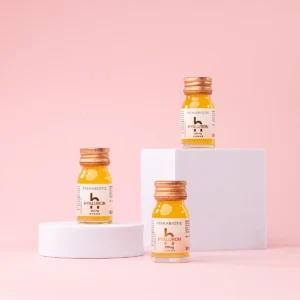
What Damages Hyaluronic Acid?
Hyaluronic acid is a natural substance found in our skin, responsible for hydration and elasticity. Unfortunately, its levels can decline due to a number of factors that “destroy” or break it down. The main ones include free radicals, UV radiation, certain enzymes, and unhealthy lifestyle habits. As a result, our skin loses firmness and becomes more prone to dryness. In this article, you’ll find out exactly what speeds up the degradation of hyaluronic acid and how you can counteract it.
Hyaluronic Acid – Why Is It Important for the Skin?
Hyaluronic acid is a natural component of the body, present in the skin, joints and eyes. Its “superpower” lies in the ability to bind large amounts of water, keeping the skin smooth and supple. It works like a sponge that maintains hydration from within.
The challenge is that hyaluronic acid isn’t permanent – it is constantly produced and broken down in the body. What damages hyaluronic acid? With age and under the influence of external factors, it starts to decline faster than the body can replenish it.
What Damages Hyaluronic Acid in the Body?
Hyaluronic acid in the body isn’t static – it’s created, fulfils its role, and is then broken down. This cycle is natural and necessary. The problem arises when degradation occurs faster than production, leading to a shortage. This causes reduced hydration, loss of elasticity, and faster appearance of ageing signs.
The rate of hyaluronic acid loss is influenced both by internal processes and external factors. Below are the main ones.
Enzymes – “Scissors” for Hyaluronic Acid
Our body contains enzymes called hyaluronidases, which naturally break down hyaluronic acid. This process is normal and helps maintain tissue balance. However, when enzyme activity increases (e.g. during inflammation), hyaluronic acid disappears more rapidly.
Free Radicals and Oxidative Stress
Free radicals are molecules that, in excess, cause significant damage. They are generated by UV radiation, air pollution, and smoking. They also attack hyaluronic acid, breaking its molecules into smaller fragments.
Sunlight and Photo-Ageing
Sunlight – specifically UVA and UVB rays – accelerates the production of free radicals that destroy hyaluronic acid. The effect? Reduced hydration and elasticity of the skin. This is why unprotected skin often dries out and loses firmness after years of sun exposure.
Sugar and Glycation
Excess sugar in the diet and high blood glucose lead to glycation – a process in which sugars “stick” to proteins and other molecules, damaging their structure. This also increases free radical levels, further attacking hyaluronic acid.
Inflammation
Chronic inflammation in the body – even low-level – raises the number of enzymes breaking down hyaluronic acid. At the same time, more free radicals appear, speeding up the degradation.
Pollution and Cigarette Smoke
Breathing polluted air and exposure to cigarette smoke contribute to oxidative stress. As a result, the skin loses hyaluronic acid more quickly, and its structure weakens.
Bacteria and Enzymes
Certain bacteria can produce their own hyaluronidases. During infections, they may locally break down hyaluronic acid in tissues.
High Temperature and Treatments
Saunas, long hot baths, and some aesthetic treatments (especially those involving intense heat or light) can increase free radicals or stimulate enzymes that break down hyaluronic acid. This doesn’t mean they must be avoided altogether – moderation and proper settings are key.
Natural Ageing
With age, the body naturally produces less hyaluronic acid. This is a physiological process – even without additional “harmful” factors, hyaluronic acid simply decreases over time.
How to Protect Hyaluronic Acid from Degradation
Now that we know what damages hyaluronic acid, let’s focus on how to slow its breakdown. Degradation is natural, but many daily habits can significantly reduce its pace, helping skin remain healthy, firm, and well-hydrated.
- Protect your skin from the sun – daily SPF limits free radical formation.
- Eat antioxidant-rich foods – vegetables, fruit, nuts, green tea neutralise free radicals.
- Reduce sugar – less glycation means slower ageing.
- Avoid cigarette smoke and pollution – lowers oxidative stress and inflammation.
- Keep skin hydrated and support its barrier – good skincare promotes natural HA production.
- Consider supplementation – hyaluronic acid, vitamin C, collagen peptides can be supportive. Always choose safe, tested products.
- Lead a healthy lifestyle – good sleep, exercise, and balanced diet benefit the skin and body.
Hyaluronic Acid – What to Watch Out For and How to Care for It
Hyaluronic acid is a key component of skin hydration and elasticity. With age, and under the influence of sunlight, free radicals, sugar and pollution, its levels decline. The good news is we can slow this process – by protecting against UV, eating healthily, avoiding harmful habits, and caring for the skin inside and out.
A valuable addition to skincare can also be supplementation – for example, Primabiotic Hyaluronic Acid, which combines both high- and low-molecular forms. This dual action works on the surface and deeper layers of the skin. Importantly, Primabiotic’s formula is based on ingredients tested for safety and effectiveness.
Check out the other articles:
